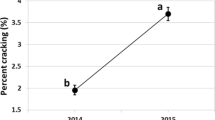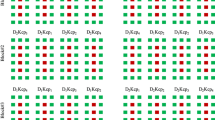Abstract
In arid regions, saline soils naturally rich in trace elements require identifying new crops and implementing management strategies for sustaining crop production and protecting water quality. Poor quality water produced from such soils can be utilized to grow specialty crops that are specifically selected for tolerance to high salt and B, such as pomegranates. The goal of this study was to evaluate the physiological responses related to nutritional quality in fruit from 1-year-old pomegranate trees irrigated for 3 years with typical poor quality water (i.e., that found in the western San Joaquin Valley, CA) containing high salinity (ranging from 3 to 9 dS m−1), Se (0.25 mg Se L−1) and B (4 mg B L−1) in a micro-plot tile system where the root system was laterally confined. This study shows that the young pomegranate trees tolerated irrigation with poor water quality containing high salinity, Se and B for 3 years. Under these treatments and growing conditions, fruit were smaller but contained higher concentrations of phenolic compounds than the same variety of pomegranates grown under unconfined root system and irrigated with good quality water. The juice produced from fruit collected from these trees contained Se (up to 0.24 mg L−1), as well as high concentrations of nutrients, including antioxidant phenolic compounds. The production of nutrient-enriched pomegranate fruit and juice may represent higher market value crop products using the poor quality water as a source of irrigation.






Similar content being viewed by others
References
Al-Maiman SA, Ahmad D (2002) Changes in physical and chemical properties during pomegranate (Punica granatum L.) fruit maturation. Food Chem 76:437–441
Ayars JE (2009) Sustaining irrigated agriculture in arid areas: lessons learned in the San Joaquin Valley. Am Soc Agric Biol Eng Annu Int Meet 2009:271–283
Baiocchi G, Distaso W (2003) GRETL: econometric software for the GNU generation. J Appl Econom 18:105–110
Bañuelos GS, Akohoue S (1994) Comparison of microwave digestion with block digestion for selenium and boron analysis in plant tissues. Commun Soil Sci Plant Anal 25:1655–1670
Bañuelos GS, Lin ZQ (2006) Reuse of agricultural drainage water in central California: phytosustainability in soil with high levels of salinity and toxic trace elements. Geol Soc Lond Spec Publ 266:79–88
Bañuelos GS, Lin ZQ (2010) Cultivation of the Indian fig Opuntia in selenium-rich drainage sediments under field conditions. Soil Use Manag 26:167–175
Bañuelos GS, Meek DW (1990) Accumulation of selenium in plants grown on selenium-treated soil. J Environ Qual 19:772–777
Bañuelos GS, Meek DW, Hoffman GJ (1990) The influence of selenium, salinity, and boron on selenium uptake in wild mustard. Plant Soil 127:201–206
Bañuelos GS, Pasakdee S, Finely JW (2003a) Growth response and selenium and boron distribution in broccoli varieties irrigated with poor quality water. J Plant Nutr 26:2537–2549
Bañuelos GS, Sharmarsakar S, Cone D, Stuhr G (2003b) Vegetative approach for improving the quality of water produced from soils in the westside of central California. Plant Soil 249:229–236
Baslam M, Garmendia I, Goicoechea N (2013) Enhanced accumulation of vitamins, nutraceuticals and minerals in lettuces associated with arbuscular mycorrhizal fungi (AMF): a question of interest for both vegetables and humans. Agriculture 3:188–209
Benhassaini H, Fetati A, Hocine AK, Belkhodja M (2012) Effect of salt stress on growth and accumulation of proline and soluble sugars on plantlets of Pistacia atlantica Desf. subsp. atlantica used as rootstocks. Biotechnol Agron Soc Environ 16:159–165
Bhantana P, Lazarovitch N (2010) Evapotranspiration, crop coefficient and growth of two young pomegranate (Punica granatum L.) varieties under salt stress. Agric Water Manag 97:715–722. doi:10.1016/j.agwat.2009.12.016
Centofanti T, Bañuelos GS, Wallis CM, Ayars JE (2017) Deficit irrigation strategies and their impact on yield and nutritional quality of pomegranates. Fruits 72:47–54
CIE Colorimeter Committee (1974) Technical notes: working program on colour differences. J Opt Soc Am 64:896–897
Di Nunzio M, Toselli M, Verardo V, Caboni MF, Bordoni A (2013) Counteraction of oxidative damage by pomegranate juice: influence of the cultivar. J Sci Food Agric 93:3565–3573
Díaz FJ, Benes SE, Grattan SR (2013) Field performance of halophytic species under irrigation with saline drainage water in the San Joaquin Valley of California. Agric Water Manag 118:59–69
Fischer UA, Carle R, Kammerer DR (2011) Identification and quantification of phenolic compounds from pomegranate (Punica granatum L.) peel, mesocarp, aril and differently produced juices by HPLC-DAD–ESI/MSn. Food Chem 127:807–821
Galindo A, Rodríguez P, Collado-González J, Cruz ZN, Torrecillas E, Ondoño S, Corell M, Moriana A, Torrecillas A (2014) Rainfall intensifies fruit peel cracking in water stressed pomegranate trees. Agric For Meteorol 194:29–35
Gil MI, Tomas-Barberan FA, Hess-Pierce B, Holcroft DM, Kader AA (2000) Antioxidant activity of pomegranate juice and its relationship with phenolic composition and processing. J Agric Food Chem 48:4581–4589
Hepaksoy S, Aksoy U, Can HZ, Ul MA (2000) Determination of relationship between fruit cracking and some physiological responses, leaf characteristics and nutritional status of some pomegranate varieties. Série A Séminaires Méditerranéens 42:81–86
Hunter RS (1942) Photoelectric tristimulus colorimetry with three filters. In: NBS circular C429, Department of Commerce, Washington, D.C
Jurenka J (2008) Therapeutic applications of pomegranate (Punica granatum L.): a review. Altern Med Rev 13:128–144
Karimi HR, Hasanpour Z (2014) Effects of salinity and water stress on growth and macro nutrients concentration of pomegranate (Punica granatum L.). J Plant Nutr 37:1937–1951
Letey J, Williams CF, Alemi M (2002) Salinity, drainage and selenium problems in the Western San Joaquin Valley of California. Irrig Drain Syst 16:253–259
Marschner H (2011) Marschner’s mineral nutrition of higher plants. Academic Press, London
Martínez JJ, Melgarejo P, Hernández F, Salazar DM, Martínez R (2006) Seed characterisation of five new pomegranate (Punica granatum L.) varieties. Sci Hortic (Amsterdam) 110:241–246
Mellisho CD, Egea I, Galindo A, Rodríguez P, Rodríguez J, Conejero W, Romojaro F, Torrecillas A (2012) Pomegranate (Punica granatum L.) fruit response to different deficit irrigation conditions. Agric Water Manag 114:30–36
Mikkelsen RL, Page AL, Haghnia GH (1988) Effect of salinity and its composition on the accumulation of selenium by alfalfa. Plant Soil 107:63–67
Mirdehghan SH, Rahemi M (2007) Seasonal changes of mineral nutrients and phenolics in pomegranate (Punica granatum L.) fruit. Sci Hortic (Amsterdam) 111:120–127
Naeini MR, Khoshgoftarmanesh AH, Lessani H, Fallahi E (2004) Effects of sodium chloride-induced salinity on mineral nutrients and soluble sugars in three commercial cultivars of pomegranate. J Plant Nutr 27:1319–1326
Naeini MR, Khoshgoftarmanesh AH, Fallahi E (2006) Partitioning of chlorine, sodium, and potassium and shoot growth of three pomegranate cultivars under different levels of salinity. J Plant Nutr 29:1835–1843
Neocleous D, Vasilakakis M (2008) Fruit quality of red raspberry as affected by salinity. Eur J Hortic Sci 73:131–137
Ohlendorf HM, Santolo GM (1994) Kesterson reservoir-past, present, and future: an ecological risk assessment. Selenium Environ 10:69–117
Okhovatian-Ardakani AR, Mehrabanian M, Dehghani F, Akbarzadeh A (2010) Salt tolerance evaluation and relative comparison in cuttings of different pomegranate cultivars. Plant Soil Environ 56:176–185
Oster JD, Grattan SR (2002) Drainage water reuse. Irrig Drain Syst 16(4):297–310
Pena ME, Artés-Hernández F, Aguayo E, Martínez-Hernández GB, Galindo A, Artés F, Gómez PA (2013) Effect of sustained deficit irrigation on physicochemical properties, bioactive compounds and postharvest life of pomegranate fruit (cv. “Mollar de Elche”). Postharvest Biol Technol 86:171–180
Radunić M, Jukić Špika M, Goreta Ban S, Gadže J, Díaz-Pérez JC, MacLean D (2015) Physical and chemical properties of pomegranate fruit accessions from Croatia. Food Chem 177:53–60
Rajasekar D, Akoh CC, Martino KG, MacLean DD (2012) Physico-chemical characteristics of juice extracted by blender and mechanical press from pomegranate cultivars grown in Georgia. Food Chem 133:1383–1393
Rashed A, Wallis CM, Paetzold L, Workneh F, Rush CM (2013) Zebra chip disease and potato biochemistry: tuber physiological changes in response to “Candidatus Liberibacter solanacearum” infection over time. Phytopathology 103:419–426
Rozema J, Schat H (2013) Salt tolerance of halophytes, research questions reviewed in the perspective of saline agriculture. Environ Exp Bot 92:83–95
Schlenk D, Zubcov N, Zubcov E (2003) Effects of salinity on the uptake, biotransformation, and toxicity of dietary seleno-l-methionine to rainbow trout. Toxicol Sci 75:309–313
Sentandreu E, Cerdán-Calero M, Sendra JM (2013) Phenolic profile characterization of pomegranate (Punica granatum) juice by high-performance liquid chromatography with diode array detection coupled to an electrospray ion trap mass analyzer. J Food Compos Anal 30:32–40
Sgherri C, Kadlecová Z, Pardossi A, Navari-Izzo F, Izzo R (2008) Irrigation with diluted seawater improves the nutritional value of cherry tomatoes. J Agric Food Chem 56:3391–3397
Singh RS, Sharma BD, Bhargava R, More TA (2011) Introduction and evaluation of anardana type pomegranate under hot arid conditions. Acta Hortic 890:239–242
Singleton VL, Orthofer R, Lamuela-Raventós RM (1998) Analysis of total phenols and other oxidation substrates and antioxidants by means of Folin–Ciocalteu reagent. Methods Enzymol 299:152–178
Teixeira da Silva JA, Rana TS, Narzary D, Verma N, Meshram DT, Ranade SA (2013) Pomegranate biology and biotechnology: a review. Sci Hortic (Amsterdam) 160:85–107
Tezcan F, Gültekin-Özgüven M, Diken T, Özçelik B, Erim FB (2009) Antioxidant activity and total phenolic, organic acid and sugar content in commercial pomegranate juices. Food Chem 115:873–877
Tzulker R, Glazer I, Bar-Ilan I, Holland D, Aviram M, Amir R (2007) Antioxidant activity, polyphenol content, and related compounds in different fruit juices and homogenates prepared from 29 different pomegranate accessions. J Agric Food Chem 55:9559–9570. doi:10.1021/jf071413n
Viuda-Martos M, Fernández-López J, Pérez-Álvarez JA (2010) Pomegranate and its many functional components as related to human health: a review. Compr Rev Food Sci Food Saf. 9:635–654
Wallis CM, Chen J, Civerolo EL (2012) Zebra chip-diseased potato tubers are characterized by increased levels of host phenolics, amino acids, and defense-related proteins. Physiol Mol Plant Pathol 78:66–72
Acknowledgements
We would like to thank Ms. Teagan Zoldoske, Ms. Anna Allen and Mr. Justin King for their assistance during field and laboratory operations. In addition, a special thank you to Mr. Irvin Arroyo and Dr. Clemencia Zambrano for their invaluable analytical and technical contribution to this study. We would also like to thank Dr. David Zoldoske, director of the Center for Irrigation Technology and California Water Institute at California State University Fresno.
Author information
Authors and Affiliations
Corresponding author
Additional information
Mention of specific products is for identification and does not imply endorsement by the US Department of Agriculture to the exclusion of other suitable products or suppliers. Any use of trade, firm, or product names is for descriptive purposes only and does not imply endorsement by the US Government.
Electronic supplementary material
Below is the link to the electronic supplementary material.
Rights and permissions
About this article
Cite this article
Centofanti, T., Bañuelos, G. & Wallis, C.M. Fruit quality of pomegranate grown in arid environment and irrigated with saline water. Sustain. Water Resour. Manag. 4, 951–964 (2018). https://doi.org/10.1007/s40899-017-0191-7
Received:
Accepted:
Published:
Issue Date:
DOI: https://doi.org/10.1007/s40899-017-0191-7




